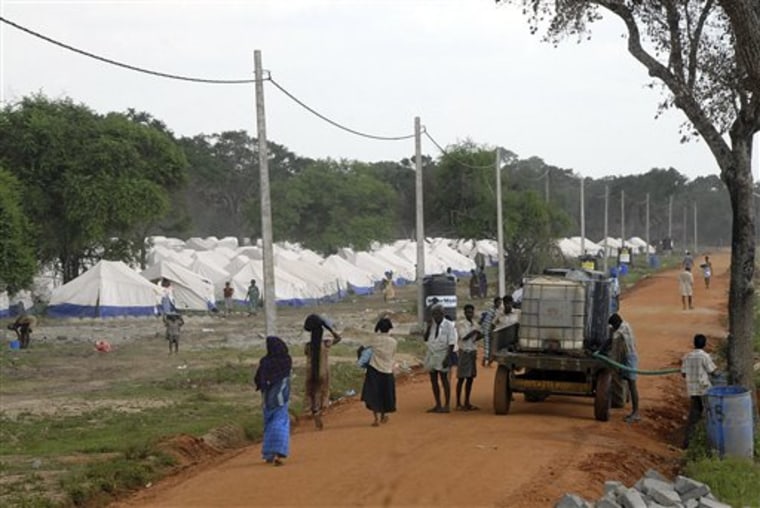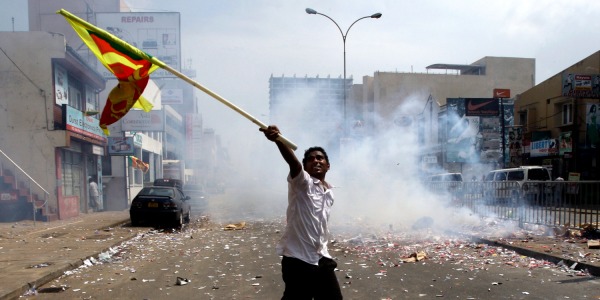In just six months, one of the world's largest camps for war refugees has been carved out of the jungles of northern Sri Lanka, complete with banks, post offices, schools and a supermarket. But no one is allowed out, and hardly anyone is allowed in.
Aid workers and foreign diplomats increasingly fear that Manik Farm, a facility they helped build, is actually a military-run internment camp where 210,000 ethnic Tamil civilians displaced by the civil war are being held indefinitely. Government memos and U.N. documents obtained by The Associated Press, as well as interviews with more than two dozen aid workers, U.N. officials, diplomats and rights advocates, detail how the international community poured tens of millions of dollars into these camps, despite their concerns.
"At best, it is at the edge of all kinds of international principles," said one Western diplomat based in Colombo, who spoke on condition of anonymity for fear of reprisals from the government. "But more likely, it is illegal."
The documents and interviews also reveal what appear to be worsening conditions at the camp, which houses civilians displaced in the final, bloody battles of the quarter-century civil war that ended two months ago.
In June, chicken pox was rampant and cases of typhoid, tuberculosis, skin and respiratory infections, hepatitis A, scabies and diarrhea have begun cropping up, according to U.N. reports. More than 35 percent of children under 5 are suffering from wasting, or acute malnutrition, according to a July 3 government presentation leaked to the AP.
Tents meant for five are packed with up to 15 people, water is scarce and the seasonal rains expected in the coming weeks could create a health nightmare, several foreign aid workers said. Relatives are not allowed to visit, although many gather at the barbed wire fence hoping to get messages to their loved ones. Opposition lawmakers are barred as well, and independent journalists are only allowed in on rare, military-guided tours.
Signs of unrest are growing
Several weeks ago, inmates held a protest demanding they be reunited with family members in other fenced-off sections of the camp, aid workers said. Military troops shot in the air to disperse the angry residents.
The Sri Lankan government has branded Manik Farm a "welfare village," where children can go to school, parents can get vocational training and those traumatized by the war can get medical and social care. Sri Lankan officials say most of the refugees will be able to return to their homes by the end of the year, and that they will open up the camps after they screen out former Tamil Tiger rebels who could stir up trouble.
However, aid workers say the military officer in charge told them almost no war refugees would go home this year, and the screening process is dragging on, with even civilians who fled the war in January still confined to the camps.
Slideshow 22 photos
Destruction, destitution in Sri Lanka
Mano Ganesan, an ethnic Tamil parliamentarian, said the government sealed the camps to keep those inside from telling the world about the final months of the war, when human rights groups say the military killed thousands of civilians with heavy shelling.
"There is no other logical reason to understand the government's position," he said.
The civil war in Sri Lanka pitted the government of this island off the southern coast of India against one of the world's most sophisticated insurgencies, which was fighting for a separate state for the Tamil minority. The battle raged across the Tamil Tigers' shadow state in the north. The U.N. says the conflict killed between 80,000 and 100,000 people since 1983.
By last August, government forces appeared to finally have the upper hand. Anticipating a wave of civilians fleeing the fighting, the U.N. High Commissioner for Refugees drew up a three-page memo Aug. 29 setting out the conditions it would require to help Sri Lanka set up displacement camps. The camps should be run by a civilian administration, and the displaced should be guaranteed "full and unhindered freedom of movement," the memo noted.
In January, the government asked international donors to help build five camps — with 39,000 semi-permanent homes, 7,800 toilets and 390 community centers — to hold civilians for up to three years.
Aid workers feared they were being asked to build military-run prison camps to indefinitely detain hundreds of thousands of civilians, according to an official who took part in meetings with the government. They decided to provide temporary tents instead of shacks and to make only a three-month commitment to the camps.
In four days in the middle of April, more than 100,000 civilians escaped the war zone. The same month, a U.N. document reported that armed soldiers and some paramilitary groups were stationed inside the camps. In a private memo written at that time, Walter Kaelin, a senior U.N. official, demanded a time frame for the civilians to be freed from the camps.
By the end of the war in May, nearly 300,000 civilians were living in schools and displacement camps. The largest was Manik Farm, so densely populated it would stand as the second-largest city in the country. Aid groups put up 43,000 shelters and tents, 8,761 latrines, 339 places to bathe, 12 nutrition centers and 132 temporary learning spaces for students, according to the U.N.
Aid groups continued to help well after their initial three-month commitment expired, despite ongoing concerns. The head of one group said the major agencies and the U.N. "are incapable of negotiating or playing hardball with the government."
The conflict exposes a major dilemma aid groups and donors worldwide face: They feel bound to assist desperate civilians, yet such work might support government policies they strongly protest.
'A great wrong'
Most of the aid officials spoke to the AP on condition of anonymity out of fear the government would further restrict their access to the camps or expel their organizations from the country. In recent weeks, the government demanded agencies sign agreements promising not to make "public comments" about camp conditions without authorization. It asked the Red Cross, one of the more critical groups, to "scale down" its operations.
As an AP journalist interviewed one agency head, five immigration officials raided his office to ensure his foreign staff had the proper visas. The AP has not been allowed into the camps since May, and requests to interview Maj. Gen. G. A. Chandrasiri, the military official who ran the camps until he was named governor of the Northern Province on Wednesday, have gone unanswered.
"We are doing a great wrong to these people," former Chief Justice Sarath Silva said after a visit to Manik Farm last month, just days before his retirement.
Slideshow 22 photos
Destruction, destitution in Sri Lanka
Paikiasothy Saravanamuttu, executive director of the Center for Policy Alternatives, a local public policy group, said Manik Farm and the other facilities are "internment camps or detention camps." His group filed a suit in the Supreme Court last month accusing the government of illegally detaining hundreds of thousands of its own citizens.
Ganesan filed a second suit, with four other opposition lawmakers, demanding access to what he called "more or less prison camps."
That description angered Resettlement Minister Rishard Badurdeen.
"That is wrong. People are very happy there," he said.
No time frame for release
Badurdeen said the government has allowed more than 3,000 people over the age of 60 to leave the camps and resettled several thousand people since May who were displaced in fighting in 2007. He said the government needs to finish registering and screening the camp residents, and that authorities have already pulled out nearly 10,000 former insurgents for rehabilitation.
Badurdeen declined to give a time frame for when the refugees can be released: "After the registration, we can consider it, along with security concerns."
Government officials say they cannot return the civilians to their former homes until the north is demined and certified safe by the United Nations.
"Every square centimeter has been mined by the LTTE (the rebels). If something happens, I am responsible," President Mahinda Rajapaksa told the Indian newspaper The Hindu in a recent interview.
Demining experts say Rajapaksa is grossly exaggerating the problem, with one estimating that only 2 to 3 percent of the region might be mined. Experts said it would take about six months to remove unexploded shells from towns and fields and to mark off the minefields so residents don't wander into them. But deminers have been barred from all but a tiny corner of the former war zone, said three people involved in the demining process.
Ganesan said he feared the government was using the mines as an excuse to keep civilians out so it could set up armed military camps across the north.
Limited resources
In the meantime, military officials are pushing to make the facilities at the camps more permanent — a move many aid workers had long feared.
When temporary latrines overflowed from use by more than 100 people each — 2 1/2 times their intended capacity — military commanders demanded concrete latrines. The aid groups offered to build more wooden latrines instead.
With heavy rains expected in the coming weeks, military commanders suggested giving residents bags of cement to pour foundations for their tents. The aid groups protested that cement floors could become the foundations for permanent structures.
Some infrastructure is going up. The army ran electricity lines to power lights and loudspeakers. UNICEF laid pipe to bring in water from a nearby river.
The government says 80 percent of those in the camps will return home by the end of the year. But Chandrasiri told aid officials that no more displaced families would go home in the next six months and only 20 percent within a year, said an official at the meeting. Meanwhile, the government is clearing more sites and building more camps.
"At the current rate, they will still be building the camp at the time they should be taking it down," the official said.
The pressure is growing on the government to compromise.
The U.N. called for $270 million in aid to Sri Lanka this year, but only $96 million has been promised. The lack of funds forced aid groups have cut back on fruit and vegetables for the camps, leaving many with little more than rice and lentils.
The camps cost nearly $400,000 a day to operate. Foreign governments will be hesitant to pledge more if conditions don't change, and Sri Lanka would be hard pressed to pay on its own.
"We can't keep these people very long in a refugee camp. We don't have the resources," said Badurdeen, the resettlement minister.
Neil Buhne, head of the U.N. mission in Sri Lanka, said aid agencies would review the situation in the camps in mid-August, but declined to say whether they would pull out if the gates remained shut.
For now, those trapped inside worry about their future, Buhne said.
"Every time I go to the camps more people ask me, 'When are we going to be let out?'"

